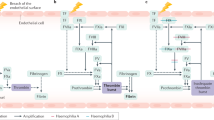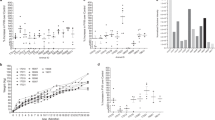Abstract
Hemophilia A and B coagulation defects, which are caused by deficiencies of Factor VIII and Factor IX, respectively, can be bypassed by administration of recombinant Factor VIIa. However, the short half-life of recombinant Factor VIIa in vivo negates its routine clinical use. We report here an in vivo method for the continuous generation of Factor VIIa. The method depends on the implantation of a porous chamber that contains Factor Xa or XIIa, and continuously generates Factor VIIa bypass activity from the subject's own Factor VII, which enters the chamber by diffusion. Once inside, the Factor VII is cleaved to Factor VIIa by the immobilized Factor Xa or XIIa. The newly created Factor VIIa diffuses out of the chamber and back into the circulation, where it can bypass the deficient Factors VIII or IX, and enable coagulation to occur. In vitro, this method generates sufficient Factor VIIa to substantially correct Factor VIII-deficient plasma when assessed by the classical aPTT coagulation assay. In vivo, a Factor XIIa peritoneal implant generates bypass activity for up to one month when tested in rhesus monkeys. Implantation of such a chamber in a patient with hemophilia A or B could eventually provide a viable alternative to replacement therapies using exogenous coagulation factors.
This is a preview of subscription content, access via your institution
Access options
Subscribe to this journal
Receive 12 print issues and online access
$259.00 per year
only $21.58 per issue
Buy this article
- Purchase on SpringerLink
- Instant access to full article PDF
Prices may be subject to local taxes which are calculated during checkout




Similar content being viewed by others
References
Bloom, A.L. Progress in clinical management of haemophilia. Thromb. Haemostasis 66, 166–177 ( 1991).
Rosendaal, F.R., Smit, C. & Briet, E. Hemophilia treatment in historical perspective: a review of medical and social developments. Ann. Hematol. 62, 5– 15 (1991).
Thompson, A.R. Molecular biology of the Hemophilias. Prog. Hemostasis Thromb. 10, 175–214 ( 1991).
Bloom, A.L. Management of factor VIII inhibitors: evolution and current status. Haemostasis 22, 268–275 (1992).
Sultan, Y. & Algiman, M. Treatment of factor VIII inhibitors . Blood Coag. Fibrinolysis 1, 193– 199 (1990).
Nilsson, I.M. The management of Hemophilia patients with inhibitors. Transfusion Med. Rev. 6, 285–293 ( 1992).
Hedner, U. & Glazer, S. Management of Hemophilia patients with inhibitors. Hematol. Oncol. Clin. North Am. 6, 1035–1046 (1992).
Kasper, C.K. Complications of Hemophilia A treatment: factor VIII inhibitors. Ann. N.Y. Acad. Sci. 614, 97–105 (1991)
Abildgaard, U., Sandset, P.M., Andersson, T.R., Odegaard, O.R. & Rosen, S. The inhibitors of factor VII in plasma measured with a sensitive chromogenic substrate assay: comparison with antithrombin, protein C and heparin cofactor II in clinical material. Folia Haematol. Int. Mag. Klin. Morphol. Blutforsch. 115, 274– 277 (1988).
Kelly, P. & Penner, J.A. Antihemophilic factor inhibitors. Management with prothrombin complex concentrates. J.A.M.A. 236, 2061–2064 (1976).
Kurczynski, E.M. & Penner, J.A. Activated prothrombin concentrate for patients with factor VIII inhibitors. N. Engl. J. Med. 291, 164–167 ( 1974).
Lusher, J.M. et al. Efficacy of prothrmbin–complex concentrates in Hemophiliacs with antibodies to factor VIII: a multicenter therapeutic trial. N. Engl. J. Med. 303, 421–425 (1980).
Giles, A.R. By what mechanisms could prothrombin complex concentrates promote factor VIII activity in vivo? Tranfusion Med. Rev. 1, 131–137 (1987).
Hedner, U. & Kisiel, W. Use of human factor VIIa in the treatment of two Hemophilia A patients with high–titer inhibitors. J. Clin. Invest. 71, 1836–1841 (1983).
Hedner, U., Bjoern, S., Bernvil, S.S., Tengborn, L. & Stigendahl, L. Clinical experience with human plasma-derived factor VIIa in patients with Hemophilia A & high titer inhibitors. Haemostasis 19, 335– 343 (1989).
Bell, B.A., Birch, K. & Glazer, S. Experience with recombinant factor VIIa in an infant Hemophiliac with inhibitors to Factor VIII:C undergoing emergency central line placement. A case report. Am. J. Pediatr. Hematol. Oncol. 15, 77–79 (1993).
Hedner, U. Experiences with recombinant factor VIIa in Hemophiliacs. Curr. Stud. Hematol. Blood Transf. 58, 63– 68 (1991).
Schulman, S. A therapeutic alternative for Hemophiliacs with inhibitors. Acta Paediatr. 81, 564–565 ( 1992).
Macik, B.G., Hohneker, J., Roberts, H.R. & Griffin, A.M. Use of recombinant activated factor VII for treatment of a retropharyngeal hemorrhage in a hemophilic patient with a high titer inhibitor. Am. J. Hemotol. 32, 232–234 (1989).
Schmidt, M.L., et al. Prolonged recombinant activated factor VII (rFVIIa) treatment for severe bleeding in a factor IX-deficient patient with inhibitor. Br. J. Haemotol. 78, 460–463 (1991).
Brinkhous, K.M., Hedner, U., Sarris, J.B., Diness, V. & Read, M.S. Effect of recombinant factor VIIa on the hemostatic defect in dogs with hemophilia A, Hemophilia B, & von Willibrand disease. Proc. Natl. Acad. Sci. USA 86, 1382– 1386 (1989).
Macik, B.G. et al. Safety and initial clinical efficacy of three dose levels of recombinant activated factor VII (rFVIIa): results of a phase I study. Blood, Coagul. Fibrinolysis 4, 521–527 (1993).
Telgt, D.S., Macik, B.G., McCord, D.M., Monroe, D.M. & Roberts, H.R. Mechanisms by which recombinant factor VIIa shortens the aPTT: activation of Factor X in the absence of tissue factor. Thromb. Res. 56, 603 ( 1989).
Pollock, A. & Lewis, M.J. Letter: Factor VIII inhibitor bypassing activity. Lancet 2, 43 (1976).
Thomsen, M.K. et al. Pharmacokinetics of recombinant factor VIIa in the rat: a comparison of bio-, immuno-, and isotope assays.” Thromb. Haemos. 70, 458–464 (1993).
Hedner, U., Glazer, S. & Falch, J. Recombinant activated factor VII in the treatment of bleeding episodes in patients with inherited and acquired bleeding disorders. Transfus.Med. Rev. 7, 78–83 (1993).
Osterud, B. Factor VII and haemostasis (see comments). Blood Coagul. Fibrinolysis. 1, 749–750 ( 1990).
Kisiel, W., Fujikawa, K. & Davie, E.W. Activation of bovine Factor VII (proconvertin) by Factor XIIa (activated Hageman Factor). Biochemistry 16, 4189–4194 (1977).
Broze, G.J. & Majerus, P.W. Purification and properties of human coagulation Factor VII. J. Biol. Chem. 255, 1242–1247 (1980).
Wildgoose, P., Nemerson, Y., Nielsen, F.E., Glazer, S. & Hedner, U. Measurement of basal levels of factor VIIa in Hemophilia A and B patients. Blood 80, 3255–3256 (1992).
Edgington, T.S., Ruf, W., Rehemtulla, A. & Mackman, N. The molecular biology of initiation of coagulation by tissue factor. Curr. Stud. Hematol. Blood Transfus. 58, 15–21 (1991).
Hedner, U. Factor VIIa in the treatment of haemophilia. Blood Coag. Fibrinolysis 1, 307–317 ( 1990).
Giles, A.R., Mann, K.G. & Nesheim, M.E. A combination of factor Xa and phosphatidylcholine–phosphatidylserine vesicles bypasses factor VIII in vivo. Br. J. Haematol. 69, 491–497 (1988).
Rapaport, S.I. Inhibition of factor VIIa/tissue factor-induced blood coagulation: with particular emphasis upon a factor Xa-dependent inhibitory mechanism. Blood 13, 359–365 ( 1989).
Warr, T.A., Rao, L.V. & Rapaport, S.I. Human plasma extrinsic pathway inhibitor activity: II. Plasma levels in disseminated intravascular coagulation and hepatocellular disease. Blood 74, 994– 998 (1989).
Warr, T.A., Warn-Cramer, B.J., Rao, L.V. & Rapoport, S.I. Human plasma extrinsic pathway inhibitor activity: I. Standardization of assay and evaluation of physiologic variables. Blood 74, 201–206 (1989).
Warn-Cramer, B.J., Maki, S.L., Zivelin, A. & Rapoport, S.I. Partial purification and characterization of extrinsic pathway inhibitor (the factor Xa-dependent plasma inhibitor of factor VIIa/tissue factor) Thromb. Res. 48, 11–22 (1987).
Roegoeci, E., Zaimi, O., Chindemi, P.A. & Charlwood, P.A. Absorption of plasma proteins from peritoneal cavity of normal rats. Am. J. Physiol. 256, E447–452 (1989).
Carpenter, C.B. & Lazarus, J.M. Dialysis and transplantation in the treatment of renal failure. In Harrison's principles of internal medicine, Edn. 13 (eds Isselbacher, K.J. et al.) 1281–1292 (McGraw-Hill, New York, NY; 1994).
Zaleznik, D.F. & Kasper, D.L. Intraabdominal infections and abcesses. In Harrison's principles of internal medicine , Edn. 13 (eds Isselbacher, K.J. et al.) 526– 534 (McGraw-Hill, New York, NY; 1994).
Lanza, R.P., Sullivan, S.J. & Chick, W.L. Perspectives in diabetes. Islet transplantation with immunoisolation. Diabetes 41, 1503– 1510 (1992).
Sullivan, S.J. et al. (1992). Islet transplantation using a immunoprotective membrane in dogs that had undergone a pancreatectomy. ASAIO J. 38, M450–453 ( 1992).
Soon-Shiong, P. et al. Insulin dependence in a type 1 diabetic patient after encapsulated islet transplantation. Lancet 343, 950– 951 (1994).
Handin, R.I. Disorders of coagulation and thrombosis. In Harrison's principles of internal medicine, Edn. 13 (eds Isselbacher, K.J. et al.) 1804 –1810 (McGraw-Hill, New York, NY; 1994).
Author information
Authors and Affiliations
Corresponding author
Rights and permissions
About this article
Cite this article
Ton-That, T., Doron, D., Pollard, B. et al. In vivo bypass of hemophilia A coagulation defect by Factor XIIa implant . Nat Biotechnol 18, 289–295 (2000). https://doi.org/10.1038/73727
Received:
Accepted:
Issue date:
DOI: https://doi.org/10.1038/73727
This article is cited by
-
A chamber of hope for hemophilia
Nature Biotechnology (2000)



